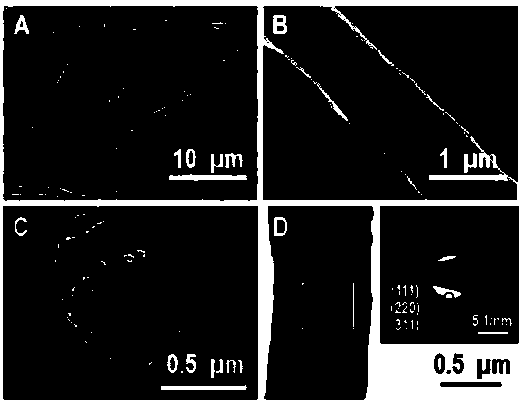Preparation method of shell-core structure nano fiber for lithium battery cathode
A nanofiber and core structure technology, applied in the field of chemical materials, can solve problems such as complex production process, temperature, and oxygen concentration requirements
- Summary
- Abstract
- Description
- Claims
- Application Information
AI Technical Summary
Problems solved by technology
Method used
Image
Examples
Embodiment 1
[0022] A method for preparing a shell-core structure nanofiber for a lithium battery negative electrode, comprising the following steps:
[0023] (1) Dissolving silicon nanoparticles and PMMA in a mixed solution of DMF and acetone to form a precursor solution of the core structure of the composite fiber finally obtained. The mass concentration of silicon nanoparticles is 4%, and the mass concentration of PMMA is 9%. The precursor solution of the core structure was stirred and dispersed in an environment of 50° C. for 6 hours; the volume ratio of DMF and acetone in the mixed solution of DMF and acetone was 1:1.
[0024] (2) Dissolve PAN in DMF to form a shell-structured precursor solution in the final composite fiber with a mass concentration of 9%. The shell-structured precursor solution was stirred and dispersed at 70°C for 7h.
[0025] (3) The coaxial electrospinning parameters are as follows: the thickness ratio of the inner and outer layers of the coaxial needle is 1:1, th...
Embodiment 2
[0029] A method for preparing a shell-core structure nanofiber for a lithium battery negative electrode, comprising the following steps:
[0030] (1) Dissolving silicon nanoparticles and PMMA in a mixed solution of DMF and acetone to form a precursor solution for the core structure of the final composite fiber. The mass concentration of silicon nanoparticles is 5%, and the mass concentration of PMMA is 11%. The precursor solution of the core structure was stirred and dispersed at 55° C. for 7 hours; the volume ratio of DMF and acetone in the mixed solution of DMF and acetone was 1:1.
[0031] (2) Dissolve PAN in DMF to form a shell-structured precursor solution in the final composite fiber with a mass concentration of 12%; the shell-structured precursor solution was stirred and dispersed at 50°C for 6h.
[0032] (3) The coaxial electrospinning parameters are as follows: the thickness ratio of the inner and outer layers of the coaxial needle is 1:1, the liquid output ratio of t...
Embodiment 3
[0035] A method for preparing a shell-core structure nanofiber for a lithium battery negative electrode, comprising the following steps:
[0036] (1) Dissolving silicon nanoparticles and PMMA in a mixed solution of DMF and acetone to form a precursor solution for the core structure of the final composite fiber. The mass concentration of silicon nanoparticles is 6%, and the mass concentration of PMMA is 12%. The precursor solution of the core structure was stirred and dispersed at 60° C. for 8 hours; the volume ratio of DMF and acetone in the mixed solution of DMF and acetone was 1:1.
[0037] (2) Dissolve PAN in DMF to form a shell-structured precursor solution in the final composite fiber with a mass concentration of 11%. The shell-structured precursor solution was stirred and dispersed at 65°C for 7.5h.
[0038](3) The coaxial electrospinning parameters are as follows: the thickness ratio of the inner and outer layers of the coaxial needle is 1:1, the liquid output ratio of ...
PUM
| Property | Measurement | Unit |
|---|---|---|
| Capacitance | aaaaa | aaaaa |
| Capacitance | aaaaa | aaaaa |
| Capacitance | aaaaa | aaaaa |
Abstract
Description
Claims
Application Information
 Login to View More
Login to View More - R&D Engineer
- R&D Manager
- IP Professional
- Industry Leading Data Capabilities
- Powerful AI technology
- Patent DNA Extraction
Browse by: Latest US Patents, China's latest patents, Technical Efficacy Thesaurus, Application Domain, Technology Topic, Popular Technical Reports.
© 2024 PatSnap. All rights reserved.Legal|Privacy policy|Modern Slavery Act Transparency Statement|Sitemap|About US| Contact US: help@patsnap.com









